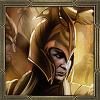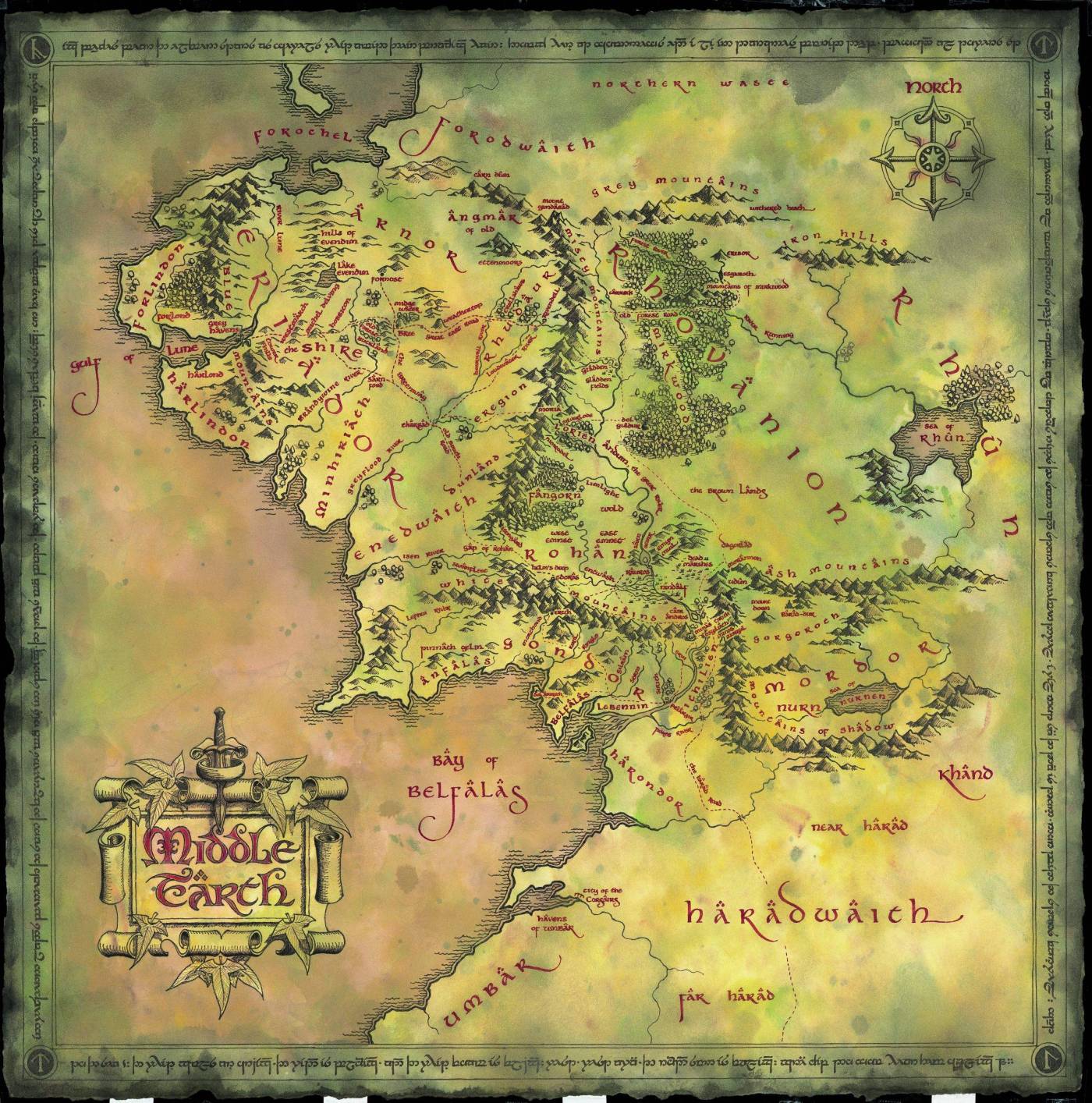The following notes was started before the first movie of "The Hobbit" did reach the cinemas, but discontinued because of my disappointment with Peter Jackson's disrespect for Tolkiens lore.
I have not added anything to the notes since, so people must take them "as is" - just a little spillover from the harddisc on my old computer.
The notes may be mainly of interest for mappers; you'll find a few geographical details and names, which are not normally known or associated to Mirkwood.
The notes are incomplete.
GREENWOOD THE GREAT / MIRKWOOD
The Silvan Elves of Mirkwood: The Farothrim
Of the Elves who undertook the Great Journey in search of the Undying Lands, the third and largest kindred were the Teleri, and because these people were so numerous their passage was slowest, and those unable or unwilling to complete the journey were in greater numbers than the other two kindred [the Vanyar and the Noldor].
The first division recorded in that journey came when the Teleri halted before the Great River Anduin and, looking beyond, saw the Misty Mountains. This mighty barrier terrified the Elves and so, rather than risk crossing the mountains, some went southwards down the Great River and lived in places unknown to others of their kin; they were named the Nandor ("those who turn back"). Some of the Nandor later crossed the mountains, and entered into Beleriand where they settled in fair Ossiriand, and there became known as the Laiquendi (the "Greenelves").
The Silvan Elves of Mirkwood were in origin of the Nandor; they became a people apart, unlike their kin, save that they loved water, and dwelt most beside falls and running streams. They were a wandering woodland folk, and they had no equal in the ways of woodlore and woodcraft. Greater knowledge they had of living things, tree and herb, bird and beast, than all other Elves. They were clad in green and brown, and hunted with bows and had weapons made from certain base metals, but they did nor know how to forge arms of steel.
In the late Third Age their weponry had greatly improved, probably through contact or trade with the Dwarws of Erebor. At that time they also used horses, which they might have got from the Northmen, either from the people of Dale or from those remnants of the kingdoms of Rhovanion still living between the eaves of Mirkwood and the River Celduin. In "The Hobbit" it is said, that "companies of the Wood-elves, sometimes with the king at their head, would from time to time ride out to hunt, or to other business in the woods and in the lands to the East."
When not in open war, the Elves mostly relied on woodcraft, stealth and enchantment; when Bilbo and the Dwarves were approching the camp-fire of the Wood-elves, "all the lights went out as if by magic" and Bilbo was "falling like a log into sleep" - next time it had been Thorin who stepped forward, and "as the lights went out he fell like a stone enchanted." Third time "the forest was fading once more into the blackness of night, when suddently out sprang sprang the light of many torches all around them. Out leaped Wood-elves with their bows and spears."
Early Elven realms of Greenwood the Great: Amon Lanc and Emyn Duir:
Dol Guldur was originally known as Amon Lanc ("Bald Hill") in Greenwood the Great. Amon Lanc was the highest point in the highland at the south-west corner of the Greenwood, and was so called because no trees grew on its summit. It had been the capital of Oropher's Silvan Elves, who had departed north to the Dark Mountains (later known as the Mountains of Mirkwood).
Oropher had come among them with only a handful of Sindar, and they were soon merged with the Silvan Elves, adopting their language and taking names of Silvan form and style. This they did deliberately; for they came from Doriath after its ruin and had no desire to leave Middle-earth, nor to be merged with the other Sindar of Beleriand, dominated by the Noldorin Exiles for whom the folk of Doriath had no great love. They wished indeed to become Silvan folk and to return, as they said, to the simple life natural to the Elves before the invitation of the Valar had disturbed it.
Long before the War of the Alliance, Oropher, King of the Silvan Elves east of Anduin, being disturbed by rumours of the rising power of Sauron, had left their ancient dwellings about Amon Lanc, across the river from their kin in Lórien. Three times he had moved northwards, and at the end of the Second Age he dwelt in the western glens of the Emyn Duir (Mountains of Mirkwood), and his numerous people lived and roamed in the woods and vales westward as far as Anduin, north of the ancient Dwarf-Road (Men-i-Naugrim).
In one of the passages in "The History of Galadriel and Celeborn" Oropher's retreat northwards within the Greenwood is ascribed [also] to his desire to move out of range of the Dwarves of Khazad-dûm and of Celeborn and Galadriel in Lórien:
In the early Second Age, the power of Galadriel and Celeborn had grown, and Galadriel, assisted in this by her friendship with the Dwarves of Moria, had come into contact with the Nandorin realm of Lórinand on the other side of the Misty Mountains. This was peopled by those Elves who forsook the Great Journey of the Eldar from Cuiviénen and settled in the woods of the Vale of Anduin; it extended into the forests on both sides of the Great River including the region where afterwards was Dol Guldur. These Elves had [in the elder days] no princes or rulers, and led their lives free of care, "but Sindar and Noldor came to dwell among them, and their 'Sindarizing' under the impact of Beleriandic culture began."
To Lórien Celeborn and Galadriel returned twice before the Last Alliance and the end of the Second Age, and it is said that Galadriel once was dwelling under the trees of Greenwood the Great. In the headnote to the Tale of Years of the Second Age it is said, that "many of the Sindar passed eastward and established realms in the forests far away. The chief of these were Thranduil in the north of Greenwood the Great, and Celeborn in the south of the forest." The settlement of Galadriel and Celeborn at Amon Lanc was only temporary, and the time of their dwelling there is nowhere recorded, but it must have been late Second Age or early Third Age.
The Silvan Elves and the War of the Last Alliance
Despite the desire of the Silvan Elves to meddle as little as might be in the affairs of the Noldor and Sindar, or of any other peoples, Dwarves, Men, or Orcs, Oropher had the wisdom to foresee that peace would not return unless Sauron was overcome. He therefore assembled a great army of his now numerous people, and joining with the lesser army of Malgalad of Lórien he led the host of the Silvan Elves to battle.
The Silvan Elves were hardy and valiant, but ill-equipped with armour or weapons in comparison with the Eldar of the West; also they were independent, and not disposed to place themselves under the supreme command of Gil-galad. Their losses were thus more grievous than they need have been, even in that terrible war. Malgalad and more than half his following perished in the great battle of the Dagorlad, being cut off from the main host and driven into the Dead Marshes. Oropher was slain in the first assault upon Mordor, rushing forward at the head of his most doughty warriors before Gil-galad had given the signal for the advance. Thranduil his son survived, but when the war ended and Sauron was slain (as it seemed) he led back home barely a third of the army that had marched to war.
The ancient Elven Path near the western eaves of Greenwood the Great
In "The Disaster of the Gladden Fields" it is told, that Isildur on his return to Arnor from the War of the Last Alliance did follow an ancient path running along the eaves of western Greenwood. Of their journey nothing is told until they had passed over the Dagorlad, and on northward into the wide and empty lands south of Greenwood the Great.
"... As they came within far sight of the forest crowning the highlands before them ... the sky became overcast and a dark wind came up from the Sea of Rhûn laden with rain. The rain lasted for four days; so when they came to the entrance to the Vales, between Lórien and Amon Lanc, Isildur turned away from the Anduin, swollen with swift water, and went up the steep slopes on its eastern side to gain the ancient paths of the Silvan Elves that ran near the eaves of the Forest.
So it came to pass that late in the afternoon of the thirtieth day of their journey they were passing the north borders of the Gladden Fields, marching along a path that led to Thranduil’s realm, as it then was. ... To their right the Forest loomed above them at the top of steep slopes running down to their path, below which the descent into the valley-bottom was gentler. Suddenly ... they heard the hideous cries of Orcs, and saw them issuing from the Forest and moving down the slopes ..."
In a note to this text it is said, that when "they had passed the deep depression of the Gladden Fields, beyond which the ground on the east side of Anduin (which flowed in a deep channel) was firmer and drier for the lie of the land changed. It began to climb northwards until as it neared the Forest Road and Thranduil's country it was almost level with the eaves of the Greenwood [At that time the people of Thranduil, the Silvan Elves of Greenwood, had migrated from the south. In the Second Age their king, Oropher (the father of Thranduil), had withdraw northward beyond the Gladden Fields, to the Mountains of Mirkwood].
Thranduil's Realm in Northern Mirkwood
After the war a long peace followed in which the numbers of the Silvan Elves grew again; but they were unquiet and anxious, feeling the change of the world that the Third Age would bring. Men also were increasing in numbers and in power. The dominion of the Númenórean kings of Gondor was reaching out northwards towards the borders of Lórien and the Greenwood. The Free Men of the North (so called by the Elves because they were not under the rule of Dúnedain, and had not for the most part been subjected by Sauron or his servants) were spreading southwards: mostly east of the Greenwood, though some were establishing themselves in the eaves of the forest and the grasslands of the Vales of Anduin.
More ominous were rumours from the further East: the Wild Men were restless. Former servants and worshippers of Sauron, they were released now from his tyranny, but not from the evil and darkness that he had set in their hearts. Cruel wars raged among them, from which some were withdrawing westward, with minds filled with hatred, regarding all that dwelt in the West as enemies to be slain and plundered. But there was in Thranduil's heart a still deeper shadow. He had seen the horror of Mordor and could not forget it. If ever he looked south its memory dimmed the light of the Sun, and though he knew that it was now broken and deserted and under the vigilance of the Kings of Men, fear spoke in his heart that it was not conquered for ever: it would arise again.
When a thousand years of the Third Age had passed a shadow fell upon Greenwood the Great, and a darkness crept slowly through the wood from the southward, and fear walked there in shadowy glades; fell beasts came hunting, and cruel and evil creatures laid there their snares. Then the name of the forest was changed, and Mirkwood it was called, for the nightshade lay deep there, and few dared to pass through, save only in the north where Thranduil’s people still held the evil at bay.
An evil presence took over Amon Lanc, and whence it came few could tell, and it was long ere even the Wise could discover it. It was the Shadow of Sauron and the sign of his return. For coming out of the wastes of the East he took up his abode in the south of the forest, and slowly he grew and took shape there again; in the hill of Amon Lanc he made his dwelling and wrought there his sorcery, and the hill was renamed Dol Guldur ("Hill of Sorcery" in Sindarin), and was also called "the dungeons of the Necromancer." All folk feared the Sorcerer of Dol Guldur, known as "the Necromancer" by the peoples, and yet they knew not at first how great was their peril.
The Silvan Elves ruled by Thranduil retreated before the Shadow as it spread ever northward, until at last Thranduil established his realm in the north-east of the forest and delved there a fortress and great halls underground. Oropher was of Sindarin origin, and no doubt Thranduil his son was following the example of King Thingol long before, in Doriath; though his halls were not to be compared with Menegroth. He had not the arts nor wealth nor the aid of the Dwarves; and compared with the Elves of Doriath his Silvan folk were rude and rustic. Thranduil's realm is said to have extended into the woods surrounding the Lonely Mountain and growing along the west shores of the Long Lake, before the coming of the Dwarves exiled from Moria and the invasion of the Dragon.
Thranduils Caverns
In "The Atlas of Tolkien's Middle-earth" it is said, that "Thranduil once had lived with Thingol and Melian, so his dwellings were understandably reminiscent of both Menegroth and Nargothrond: All lay under a wooded hill beside a river, with a stone bridge leading to the great gates; all had a great pillared hall used as a throneroom, and many twisting passages leading to other rooms of varying sizes at different levels; all had been enhanced by the mining efforts of Dwarves." Thranduil's dwelling was different in only two ways: Although extensive, it seems to have been somewhat smaller than the great ancient underground kingdoms; and it had an underground stream.
The Forest River apparently dropped rather steeply between the gate and the stream, for the main passage led to the upper galleries, while the stream originated in the heart of the hill and "flowed under part of the lowest regions of the palace, and joined the Forest River some way further to the east, beyond the steep slope out of which the main mouth opened."
When the Wood-elves captured them, the Dwarves were led over the bridge, up a stair cutting through the steep bank, across a grassy terrace, through the great gates that "closed by magic," and down twisting passages to Thranduil's great hall. As they refused to tell the Elvenking their purpose, they were imprisoned in "twelve cells in different parts of the palace." Thorin's was in "one of the inmost caves with strong wooden doors." One of these same dungeons may have been used years later to imprison Gollum.
Little was told of the remainder of the rooms except that there were upper halls large enough to allow feasting, and that "the lowest cellars" overlay the tunnel of the underground stream. It was to those cellars Bilbo led the Dwarves to escape: first Balin and last Thorin, whose cell was "fortunately not far from the cellars." The guard and butler were in the small room adjacent to the one with the trap-door, and Balin watched them while Bilbo packed the Dwarves in barrels. Once the Elves had cast the barrels into the stream, the distance seemed fairly short to where they floated under the arched portcullis into the main river.
Only a lesser part of the Elves of Mirkwood did live in Thranduil's Caverns. In "The Hobbit" it is said, that "the subjects of the king mostly lived and hunted in the open woods, and had houses or huts on the ground and in the branches [of the trees]. The beeches were their favorite trees. The king's cave was his palace, and the fortress of his people against their enemies." This probably was the inspiration for the "Talan" used in Lórien.
Northern Mirkwood
The path across Mirkwood taken by Thorin and Company was apparently fairly level but had just enough ups and downs to prevent Bilbo from even noticing that he was at the bottom of a wide valley when he climbed the great oak. This bowl-like valley might have been a hollow — that is, a valley in which the water seeps into the limestone and flows out in underground rivers. It was close enough to King Thranduil's to be in a soluble limestone bedrock. Thranduil's underground palace, complete with columns of "living stone" and "underground river, were probably limestone solution caverns, reportedly enhanced with the assistance of Dwarves.
The extensive bogs and marshes at the end of both forest roads, the Long Marshes along the Forest River, the "tumbled land" between Lonely Mountain and its nearest neighbors to the northeast, and most especially the description of Long Lake, all point toward effects of continental glaciation. The "shingles" piled at the feet of the promontory near Lake-town could easily have resulted from glacial till — a conglomeration of rocks ranging from gravels to boulders, which the glacier had captured and carried along. Most importantly, Long Lake "filled what must once have been a great deep rocky valley." South of Long Lake the ruggedness was absent, for, between the eaves of Mirkwood and the River Running, Rhovanion had occupied "wide plains."
The Mountains of Mirkwood
The Emyn Duir (Dark Mountains) were a group of high hills in the north-east of the Forest, so called because dense fir-woods grew upon their slopes; but they were not yet of evil name. In later days when the shadow of Sauron spread through Greenwood the Great, and its name changed from Eryn Galen to Taur-nu-Fuin (translated Mirkwood), the Emyn Duir became a haunt of many of his most evil creatures, and were called Emyn-nu-Fuin ("Mountains under nighrshade"), the Mountains of Mirkwood.
In Appendix F(II) to The Lord of the Rings the Elvish name of Mirkwood is Taur-en-Daedelos "forest of the great fear." The name given here, Taur-nu-Fuin "forest under night" was the later name of Dorthonion, the forested highland on the northern borders of Beleriand in the Elder Days. The application of the same name, Taur-nu-Fuin, to both Mirkwood and Dorthonion is notable, in the light of the close relation of Tolkien's pictures of them.
Apart from the many similarities between Mirkwood (in generel) and Dorthonion in late First Age, the most stricking fact is the almost exact mirroring of Finrod Felagund's stronghold Nargothrond unto Thranduil's Caverns: The bridge across the river, the terrace in front of the Great Gate, the great hall with columns of "living stone" and a secret gate leading to a smaller river joining the main river; The only difference being the small (underground) river in Thranduil's Caverns passing out through the lower gate.
No elvish name is given for Thranduil's Realm, but as he did know Nargothrond well, and duplicated it in his caverns, he most probably also reused some name from that renowned kingdom of old. The forest surrounding Nargothrond was known as Taur-en-Faroth ("Forest of the Hunters"), and Thranduil's people, being in origin woodelves, was living primarily as a people of hunters, or in Sindarin: Farothrim ("People of Hunters"); Thranduil would most likely choose the name of Taur-en-Faroth for his realm, even in preference to a direct translation of Mirkwood, i.e. "Eryn Vorn" (Dark Forest), which anyway also was the name of the old forest, on the peninsula south of the river Baranduin, in western Minhiriath.
Various parts of Mirkwood
The different names for Mirkwood, in Common Speech and Sindarin, reflects the forest or parts of it in various ways. The name in Common Speech, Mirkwood, denotes the former Greenwood the Great in its entity; as such, the name does not have evil connotations: an evil power had put a shadow on the forest, but the forest itself was not evil. This description fits well with the northwestern part of the forest, around the western part of the Forest Path, that Bilbo and the Dwarves followed through the forest.
After passing the Enchanted Stream [that is halfway through the forest] "if they had known more about it and considered the meaning of the hunt and the white deer that had appeared upon their path, they would have known that they were at last drawing towards ... thinner trees and places where the sunlight came again." After four days from the Enchanted Stream they came to a part where most of the trees were beeches, and there was no undergrowth and the shadow was not so deep. This was the "Forest of the Hunters" - Taur-en-Faroth - the Realm of Thranduil's Wood-elves.
[missing: Tolkiens Map of Wilderland - Woodmen west and east - the East Bigh, dividing the two evil parts of the forest]
In Taur-en-Daedelos, the "forest of the dreadful fear" in the south of Mirkwood, ever a dark shadow and cloud flowed from Dol Guldur. Gandalf did warn Thorin's company, before leaving at the entrance to Mirkwood, that "in the South, you would get into the land of the Necromancer; and even you, Bilbo, won't need me to tell you tales of that black sorcerer. I don't advice you to get anywhere near the places overlooked by his black tower!" This was the most evil part of the forest, and the stronghold of Sauron for two thousand years of the Third Age.
[missing: Taur-nu-Fuin "forest under night" - Emyn-nu-Fuin as a stronghold, from where the Old Forest Road could be controlled?]
The Old Forest Road or the Great Dwarf Road: Men-i-Naugrim
The Dwarf Road is the Old Forest Road described in The Hobbit. In "The Disaster of the Gladden Fields" there is a note referring to "the ancient Forest Road that led down from the Pass of Imladris and crossed Anduin by a bridge (that had been enlarged and strengthened for the passage of the armies of the Alliance), and so over the eastern valley into the Greenwood. The Anduin could not be bridged at any lower point; for a few miles below the Forest Road the land fell steeply and the river became very swift, until it reached the great basin of the Gladden Fields. Beyond the Fields it quickened again, and was then a great flood fed by many streams, of which the names are forgotten save those of the larger: the Gladden (Sîr Ninglor), Silverlode (Celebrant), and Limlight (Limlaith)." In The Hobbit the Forest Road traversed the great river by the Old Ford and there is no mention of there having once been a bridge at the crossing.
In "Of Dwarves and Men" it is said, that "... the Great Dwarf Road that cut through the Forest (the Old Forest Road was its ruinous remains in the Third Age) and then went North-east to the Iron Hills." In "The Hobbit" Beorn said that "the forest-road itself, he had heard, was overgrown and disused at its eastern end and led to impassable marshes where the paths had been long lost" - this forest-road was the Old Forest Road originally made by the Dwarves.
[missing: The Dwarf road build in First Age - the Great East-West road west of the Misty Mountains was part of it - before the Wood-elves had Silvan rulers?]
The Silvan Elves and the Battle of Five Armies
In "The Hobbit" it is said, of the company a]pproaching the Gate of Erebor, that "elven bowmen were among them." In the battle "the elves were the first to charge. Their hatred for the goblins is cold and bitter. Their spears and swords shone in the gloom with a gleam of chill flame, so deadly was the wrath of the hands that held them. As soon as the host of their enemies was dense in the valley, they send against it a shower of arrows, and each flickered as it fled as if with stinging fire. Behind the arrows a thousand of their spearmen lept down and charged."
Of the free peoples fighting in the Battle of Five Armies, Dáin had brought "five hundred grim dwarves" and while Bard's forces were uncertain, they may have been as few as two hundred, judging from the size of the town. It can then be safely assumed, that of the free peoples the Elves were by far the largest army; the "thousand of their spearmen" in the first charge probably were only the vanguard of Thranduil's forces.
[missing: Capture of Gollum, released by Orcs of Dol Guldur]
[missing: War of the North, "Battle under the Trees"]
Primary sources:
Tolkien: "The Hobbit"
Tolkien: The Lord of the Rings III, Appendix B, "The Third Age"
Tolkien, (ed. Christopher Tolkien): The Silmarillion, "Of the Rings of Power and the Third Age"
Tolkien, (ed. Christopher Tolkien): Unfinished Tales, "The History of Galadriel and Celeborn"
Tolkien, (ed. Christopher Tolkien): Unfinished Tales, "The Sindarin Princes of the Silvan Elves"
Tolkien, (ed. Christopher Tolkien): Unfinished Tales, "The Disaster of the Gladden Fields"
Tolkien, (ed. Christopher Tolkien): History of Middle-earth XII, "Of Dwarves and Men"
Karen Wynn Fonstad: "The Atlas of Tolkien's Middle-warth" /Wilderland /Thranduils Caverns
David Day: "A Tolkien Bestiary" /Nandor /Silvan /Sindar
____________
Edited by Námo, 12 August 2015 - 12:50 PM.
























